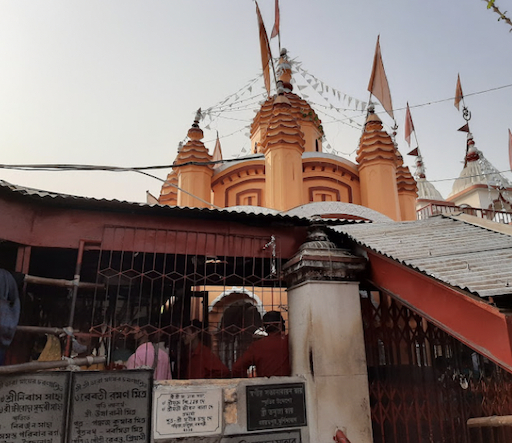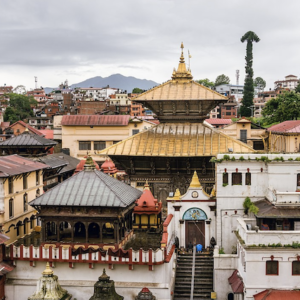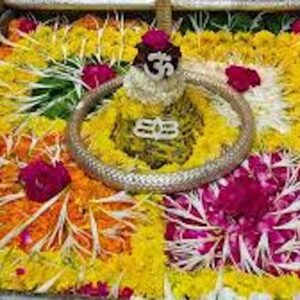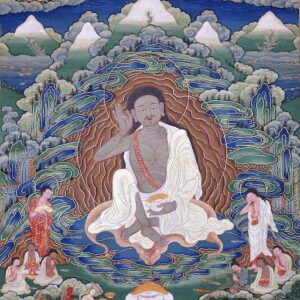This is a temple of Tarapith Shaktipeeth.
There is a place to sit and meditate outside the temple. You can go into meditative states here effortlessly.
How to Get there
The temple is located 119 kms North of Bardhman.
Map:
https://maps.app.goo.gl/Ev8jwdtctuP2D5Jo6
About Tarapith Shaktipeeth
There are several legends narrated on the origin and importance of this place, all related to the goddess Tara deified in the Tarapith temple. A well-known legend relates to the Shakti Piths. Sati, the consort of Shiva, felt insulted when her father Daksha deliberately did not invite Shiva to the great yajña “the fire sacrifice” he organized. Despite Shiva’s refusal citing that they’re not invited, when Sati however arrived to the scene, Daksha insulted Shiva by saying cuss words for him in front of all the attendants. Unable to bear this humiliation, Sati gave up her life by jumping into the yajña fire. Infuriated by this tragic turn of events, Shiva went wild. Then, Vishnu, in order to pacify Shiva, decimated the body of Sati with his chakram. Sati’s body part fell all over the Indian subcontinent. The places where the body parts fell have become centres of worship of the Goddess in different manifestations. There are 51 such holy temples which are called Shakti Piths; in West Bengal, there are many such piths, such as the Kalighat.[4]
Vashistha had seen this form and worshipped the goddess Sati in the form of Tara. Another legend describes the following: Shiva had drunk the poison that had emerged by the churning of the cosmic oceans, to save the universe. To relieve the intense burning in his throat, Sati – in the form of Tara – breast fed Shiva to relieve him of the effect of poison in his throat. Another local narration is that Vasishtha chose this place for the worship of Sati as it was already known as a Tarapith.[5] Among piths, Tarapith is a siddha pith, which grants enlightenment, wisdom, happiness and siddhis (“supernatural powers”).[6]
Another oral legend about the temple states that the sage Vashishtha practised austerities toward Tara, but was unsuccessful, so on the advice of a divine voice, he went to meet the Buddha – an avatar of Vishnu according to some schools of Hinduism – in Tibet. The Buddha instructed Vasishtha to worship Tara through the practices of vamachara. During this time, Buddha had a vision of Tarapith as an ideal location for a temple that would serve to enshrine the image of Tara. Buddha advised Vasishtha to go to Tarapith, the abode of Tara. At Tarapith, Vasishtha performed penance by reciting Tara mantra 300,000 times. Tara was pleased with Vasishtha’s penance and appeared before him. Vasishtha appealed to Tara to appear before him in the form of a mother suckling Shiva on her breast, the form that Buddha had seen in his divine vision. Tara then incarnated herself in that form before Vasishtha and turned into a stone image. Since then Tara is worshipped in the Tarapith temple in the form of a mother suckling Shiva on her breast.[5][7]
Tarapith, Kalighat and Nabadwip are considered the most important tirthas (holy places with a sacred water body) for Bengali Hindus.[6]
The shrine as a Sidhha Pith – Tarapith
The shrine gets its name being a Sidhha Pith. Sidhha Pith holy temples of Tara Maa. They are believed to have originated due to the falling of body parts of the corpse of Sati Devi, when Lord Shiva carried it and wandered in sorrow. There are 51 Shakti Peeth all over South Asia is linked to the 51 letters in Sanskrit. The Shakti Peethas are associated with the mythology of Daksha yaga and Sati’s self immolation. These shrines are important place of worship for Tantra practitioners.[8]
Read More
https://en.wikipedia.org/wiki/Tarapith







